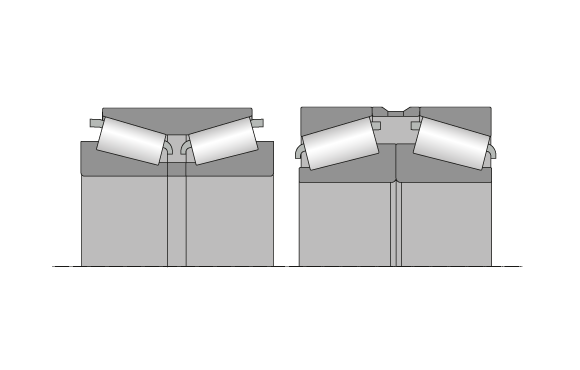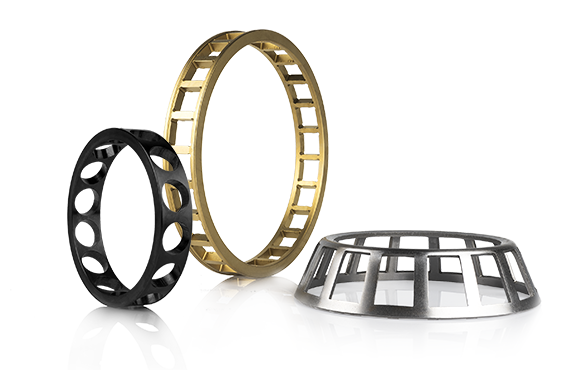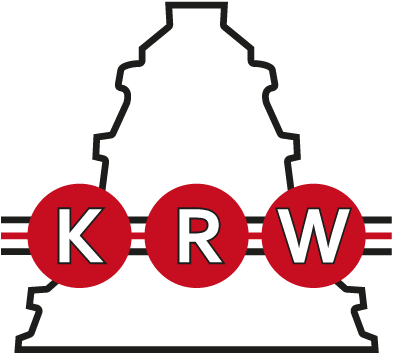
Tapered Roller Bearing
double row
- Absorption of high axial and radial forces
- Available in X- or O-arrangement
- Pre-set axial clearance or preload

Double row tapered roller bearings consist of two mirror-image arranged side by side tapered rolling element rows. Depending on arrangement, they share an inner or outer ring and are adjusted for axial clearance or pre-stress with a spacer ring. This way, they can in addition to radial forces also absorb axial forces in both directions and are suitable for medium to high speeds. Double row tapered roller bearings can be disassembled which facilitates a separate assembly of the individual bearing rings.
Dimensions and Tolerances
KRW supplies double row tapered roller bearings with normal tolerance (PN) in accordance to DIN 620-2 (Tolerances for roller bearings) and ISO 492 (Radial bearings - Dimensional and geometrical tolerances). All other deviating or special tolerances must be specified with the order.

Double row tapered roller bearings - Types TDI and TDO
Bearing Design
Double row tapered roller bearings are separable and non-latching bearings. In addition to radial forces, they can, due to the mirror-image arranged bearing, also absorb high axial forces in both directions.
For combined bearing sets there is a distinction between O-, X-, or tandem arrangement based on pressure line contact. Bearings in X-arrangement (TDI) are less suitable for the absorption of moment loads while the O-arrangement (TDO) is very rigid and only allows small overturning clearance.

Bearing Clearance
The bearing clearance is custom-made and adjusted by the manufacturer with a spacer ring.

Cage
By default, double row tapered roller bearings by KRW are equipped with a rolling element riding solid brass window-type cage (suffix: MP). Other cage designs are available on request or chosen for specific applications and labelled accordingly on the bearing.
Suffixes
Compensation of Angular Misalignments
Double row tapered roller bearings are not suitable for compensation of misalignments. Misalignments cause edge stresses between rolling elements and raceways and produce additional stresses in the bearing which reduce its operating life.
Speed
The kinematic limiting speed nG is a practical mechanical limit value and is based on the mechanical fatigue strength of the rolling bearing as a function of its installation situation and lubrication. The limit speed must not be exceeded even under optimum operating conditions without prior consultation with KRW.
The DIN ISO 15312 (Rolling bearings - Thermal speed rating) does not specify a thermal speed rating nth for these bearings.
Admissible Operating Temperatures
The admissible operating temperature of a bearing is limited by cage material, dimensional stability of the bearing components (ball race and rolling elements), as well as lubrication. By default, KRW bearings are stabilised up to 200°C (S1). KRW provides roller bearings for higher operating temperatures on request.
Dimensioning
For dynamically loaded bearings
The service life formula according to ISO 281 L10 = (C/P)p for dynamically loaded bearings requires an equivalent load (P) from constant direction and size. To calculate P, calculation factors and the ratio of axial and radial load are required.
Equivalent Dynamic Bearing Load P
The equivalent bearing service life for the tapered roller bearings depends on the ratio Fa/Fr . The equivalent dynamic bearing load can be determined using the following formula:

| P | equivalent dynamic load | [kN] |
| Fr | dynamic radial force | [kN] |
| Fa | dynamic axial force | [kN] |
| e | calculation factor, see chart | [-] |
| Y1 | calculation factor, see chart | [-] |
| Y2 | calculation factor, see chart | [-] |
For statically loaded bearings
Dynamic dimensioning loses its validity for bearings rotating at very low speeds (n x dm ≤ 4000 mm/min). The static load safety factor S0 is calculated as follows:

| S0 | static load safety factor | [-] |
| C0 | static load rating (from bearing chart) | [kN] |
| P0 | equivalent static bearing load | [kN] |
| n | speed | [min-1] |
| dm | mean bearing diameter [dm = (D+d)/2] | [mm] |
Static load capacity

| F0r | max. radial static force | [kN] |
| F0a | max. axial static force | [kN] |
| Y0 | calculation factor, see bearing chart | [-] |
Minimum Radial Load
A minimum load is required for the reliable operation of a rolling bearing. If the minimum load is not reached, slippage may occur. The minimum radial load for tapered roller bearings is roughly assumed to be 2% of the static load rating C0 of the bearing. If the value falls below this value, please consult KRW Application Technology.



